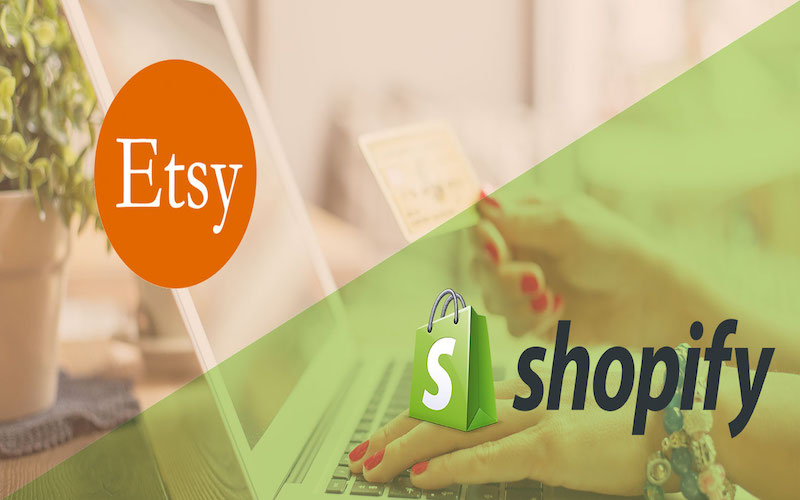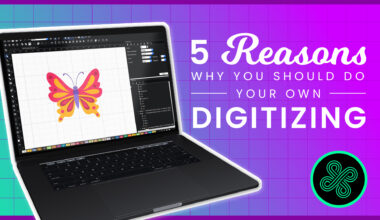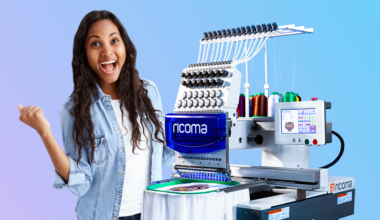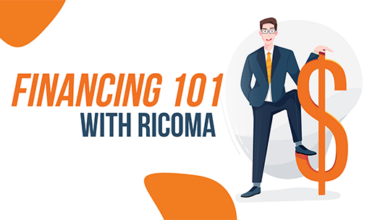Whether you’re just starting a custom apparel business or want to expand the reach of your business, you will most likely ask this question:
Where and how can I sell my products?
As a small business owner, in the beginning, you may resort to word-of-mouth marketing, attending local flea markets, or similar strategies.
But in this digital age, there are a world of options to choose from to sell your products!
Two of the top e-commerce platforms used by businesses today are: Etsy and Shopify.
Since we get many questions about which platform to use, we wanted to talk about the following:
- What is Etsy and Shopify?
- Etsy Pros
- Etsy Cons
- Shopify Pros
- Shopify Cons
- Which platform is best for your business?
If you’ve been thinking of selling your products on either of these platforms, read on to find out which one will be the best option for your business!
What is Etsy and Shopify?
Etsy and Shopify are e-commerce platforms where businesses can list and sell their products.
While both are used as a place to sell your products, there is one big difference…
With Shopify you’ll have complete control of your website, while Etsy is more limited.
Etsy is a marketplace where business owners can create an account, upload their products, and sell their products (for a fee). Your Etsy page will not have a domain name, a customizable theme or other custom features common among typical websites.
Shopify is a bit different!
Shopify is a platform where you can purchase a domain name, completely customize your site and the backend is invisible to your customers. It is your standalone website.
Now that we’ve broken down the main difference between the two, let’s dive into the pros and cons of each!
Etsy Pros
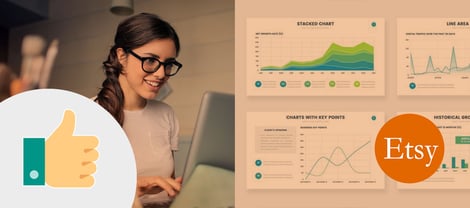
#1: Free traffic to your site
Etsy is its own brand. What does that mean for your business?
When people go to Etsy.com, they are already searching for handcrafted, customized items. This is what the marketplace and its sellers are known for.
By default, since you are selling on their platform, there is a chance that your product will come up when someone starts searching the site.
One of the key ways to drive heavier traffic to your page is to use the proper keywords in your product descriptions!
Examples of keywords in the custom apparel industry could be:
- Embroidery
- Embroidered bag
- Embroidery kit
- Vinyl poster
- Custom T-shirts
- Hand embroidery
And more!
The more relevant phrases you use in your listings, the higher your chances of acquiring a new customer without having to do any promotion or marketing of your own!
#2: Easy to setup
Most people don’t have much experience in developing and designing their own website. This is why small business owners tend to start with Etsy.
Etsy allows you to create an account, add your product images and information and begin selling. Within 30 minutes, you’re all set up to have your first sale come through!
There’s no coding, customizing or URL purchasing required.
Let’s say you own a T-shirt business and want to set up an Etsy shop to start selling your products.
All you have to do is head to Etsy.com, click ‘Sell on Etsy’ in the upper right hand corner, and create an account.
The best part…it is free to create one!
Tip: Make sure to fill out all sections of your Etsy account. Those who don’t take the time to fill out every section of their shop page tend to see less traffic.
#3: Exposure
Etsy is the place to be if you are a small business and don’t have the capital to invest in marketing for your brand.
Since Etsy already attracts millions of customers a day, the customers will flock directly to you. There isn’t much work that has to be done on your part.
Your exposure increases tremendously just by connecting your name to a brand as established as Etsy.
With Shopify, you have to invest in your own marketing and promotional materials to drive traffic to your website.
Any small business needs exposure in order to grow. If you eventually want to expand from Etsy and have your own website on Shopify, you are more likely to be successful since you can pull traffic from your existing customer list on Etsy.
And to fill that customer list, click here for an Apparel Academy podcast episode where our very own COO, Henry Ma, shares three ways to find new customers!
Etsy Cons

#1: Transaction fees
While setting up an account on Etsy is free, there are costs that need to be accounted for once you start selling:
- Transaction fee: 5% on every item you sell (includes shipping)
- Payment processing: 3% plus a quarter per transaction
- Renew listings: 20 cents per item, every four months
If your products sell frequently, you might even have to pay to renew the listing every single time it sells.
At the end of the day, you’re looking at about a 10% transaction fee per listing.
This is definitely one of the main cons of Etsy, as you don’t ever receive the full profit of selling your items. Although, most shop owners are willing to pay the 10% transaction fee if it means constant traffic to their shop.
And since you won’t be receiving the full profit from Etsy, you may want to click here to watch our webinar where we share the #1 way to maximize profitability in your embroidery business!
#2: Firm selling rules
Etsy is a marketplace for those who want to sell handmade goods, craft supplies, vintage items and more.
Because of this, Etsy is very firm on what can be sold on their website.
For example, if you wanted to list a handbag that you bought from Nordstrom to try and resell it, you wouldn’t be allowed to.
Why?
- Because you bought it pre-made from a department store
- Because you did not craft the handbag yourself
It would only count if you are a crafter who actually designs handbags and want to list your custom items on Etsy.
So, if you sell anything other than handmade crafts, you would need to find a different e-commerce platform.
#3: Competition
By far one of the biggest cons that Etsy has is the competition you face. Everyone who is using Etsy is trying to do the same thing: sell their handmade crafts.
With over 2.1 million active sellers, it can be difficult to find the visibility you need to be successful among your competitors.
There’s also no ability to customize your shop page, which means it looks the same as everyone else.
That’s why in this type of situation, keywords are crucial to being found on Etsy.
In order to stand out, you need to keep up with the search algorithm that Etsy has in place.
This could mean:
- Consistently adjusting your keywords
- Adding more relevant keywords
- Changing up your product descriptions
Implementing these key tips could help your shop stand out from other sellers, thus increasing your overall exposure.
Shopify Pros

#1: Highly customizable
Different from the basic design setup of Etsy, Shopify users can design and customize their website the way they want to.
With predetermined themes included, Shopify makes it easy for you to pick the look you want for your website.
You can also design your own website template by hiring a web developer to code one to meet your brand specifications.
You have the creative freedom to design your website, your way.
This feature is great for business owners who have a defined brand look and are concerned with the experience their customers have when exploring their website.
#2: Shopify App Store
Shopify has an app store with 3rd party contributors, where you can download extensions and apps to make the Shopify experience better.
Some of the functions of these apps include:
- Improving the functionality of your store
- Analyzing customer data
- Tracking website traffic
And more!
There are even apps that you can download to show you the click path your customer took when they were on your site, at what point they’re closing the page, how long they’re on the website for and more!
It provides a lot of useful information that can help you grow your custom apparel business!
#3: When the customers come, they come for you
The beauty of using Shopify is that there is no direct competition.
What we mean by that is your website is a stand-alone platform. There is no one else trying to sell the same handcrafted items as you are, on the same site.
In fact, if you’re worried that the market may be too saturated for you to even get into, click here to watch this Ricoma Live clip where Henry explains why it’s actually the best time to get in!
This is beneficial because if someone is visiting your site, you know that there is more of an intent to purchase and you can learn more about who is visiting your site.
Here’s an example:
Let’s say you create a website for your embroidery business and want to create a customer profile.
Shopify allows you to control the messages your customers receive, how they receive them and analyzes that information.
Since everyone on your site is most likely interested in your products and was driven there by a marketing strategy of yours (or by chance), you can safely say that their information is a good representation of who your customers are.
With the information provided to you, you can draw up their customer profile:
- Gender
- Age
- Personality
- Pain points
- Buying behavior
- Browsing behavior
This will help you in your future marketing efforts, to ensure that you are reaching the right audience.
Shopify Cons
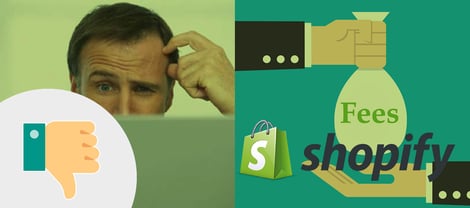
#1: You need to bring your own traffic
One of the hardest parts of calling Shopify your business’ home is that you need to bring your own traffic to the website.
Since you own the domain name on Shopify, you have to be able to promote the URL and drive people to your site.
No one will know about your website if you do not share it.
It is definitely possible that a few customers may coincidently land on your site, but it is not guaranteed.
Using Shopify is definitely recommended if you pair it with Etsy or once you have an established customer list.
#2: Fees galore!
On Shopify, there are fees that you have to pay in order to run your site on the platform. Unlike Etsy, you cannot create an account for free.
Here are some of the fees that you will have to worry about when using Shopify:
- If using Shopify Lite: $9/month
- If using Shopify Basic: $29/month
- Transaction fees: 3% and 30 cents per transaction
- Apps can have a one time or monthly fees
- Marketing costs
If you want to be able to manage everything on Shopify, you will have to invest in Shopify Basic which is more expensive than Shopify Lite.
Overall, it ends up costing more to sell on Shopify than on Etsy.
As a small business owner, you have to consider that it will take a lot more capital to get a Shopify website up and running. Once it’s running, then you have to invest in driving traffic to your page.
With the collection of fees, it’s no wonder most small custom apparel businesses start off on Etsy.
And with everything you have to pay as business owner, here at Ricoma, we try to make it easy for you to purchase your own embroidery machine. To find out more about our 0% financing offer, click here to contact us today!
#3: Learning curve
Setting your shop up on Etsy is as simple as creating an account and uploading your product images.
Shopify is a little bit more complex than that.
After creating the account, understanding the fees you have to pay and picking your website’s domain name, you have to worry about actually designing it.
While Shopify does come with pre-designed templates, there is still a lot of work that goes into adding all of the smaller parts in.
There is a learning curve when it comes to understanding how to upload the images, how to add in descriptions, what format looks appropriate for both mobile and desktop and other tasks for setting up your Shopify website.
Because of the time it takes to fully customize your website on Shopify, it ends up being more of a con than a pro.
Etsy or Shopify: Which one is best for your custom apparel business?
Choosing where to sell your products depends on where you are in your business journey.
Here’s how we can break it down easily by platform.
Do ONLY Etsy if you’re:
- Just starting your business
- Looking for brand exposure
- Tight with money
- Profiting under $1,000/month
- Want to make a low initial investment
Do BOTH Shopify and Etsy if you:
- Have a more established brand
- Want to have more creative control, but keep the consistent traffic
- Profit more than $1,000/month
- Want to pull your Etsy customers to your Shopify site
- Have more capital to work with
You can definitely do Shopify alone, but it is highly recommended for custom apparel and handcrafted businesses to do both at the same time.
Bottom Line
Each platform brings their own pros and cons to the table. In order to choose the one that is best for your business, you need to know what your goals are and how you intend to reach them.
The more you understand the ins and outs of your business, the more successful you can be, on either platform.
If you use Etsy or Shopify, share your experience with us! Let us know some of your pros and cons, and which you would recommend.
Leave a comment below or let us know on our Facebook group, Embroidery & Printing Business Help
The #1 Factor in Determining Profitability: How to price for maximum profit in the embroidery business
Are you an entrepreneur, fashion lover, or embroidery enthusiast interested in starting or growing a profitable embroidery business? Do you want to be successful?
To guarantee maximum profit in your embroidery business, we’ve put together a webinar discussing the #1 factor in determining profitability. You will learn everything from achieving optimal profit margins for your products to common myths that are costing you money.
